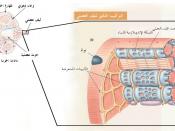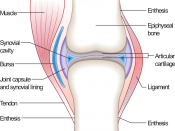HUMAN ANATOMY & PHYSIOLOGY CHAPTERS 9, 10, 12
PRE-TEST 3
1. The outermost layer of connective tissue surrounding a skeletal muscles is called the A. epimysium B. perimysium C. endomysium D. sarcomysium 2. Myofibrils are composed primarily of A. actin & myosin B. ATP & ADP C. troponin D. tropomyosin 3. Neurotransmitters are stored in vesicles within A. myofibrils B. motor units C. motor end plate D. motor neuron ending 4. The enzyme cholinesterase causes acetylcholine to A. bond to actin B. be secreted from the motor end plate C. decompose D. form cross-bridges 5. Creatine phosphate serves to A. cause the decomposition of ATP B. cause the decomposition of ADP C. supply energy for the synthesis of ATP D. supply energy for the change of ATP to ADP 6. The amount of oxygen needed to support the conversion of lactic acid to glycogen is called the A. refractory quantity B. oxygen debt C. anaerobic concentration D. aerobic conversion 7. The all-or-none response means that
A. all of the muscles in a region contract together B. all of the muscle fibers within C. when a muscle fiber contracts, it contracts completely D. when a muscle fiber contracts, all of its ATP is changed to ADP
8. An example of a partial but sustained contraction would be A. muscle tone B. tetany C. twitch D. all of the above 9. The striated appearance of skeletal muscle results from the A. transverse tubal pattern B. sarcoplasmic reticulum network C. sarcomere arrangement D. cisternae placement 10. Which of the following is NOT true when comparing red and white muscle types?
A. Red muscles contract more slowly than white. B. Red muscles contain more myoglobin than white. C. Red muscles have fewer mitochondria than white. D. Red muscles fatigue more slowly than white.


